- Camping Tips
- Hiking Tips
- RV Camping
- Destinations
- Blog
- Gear Reviews
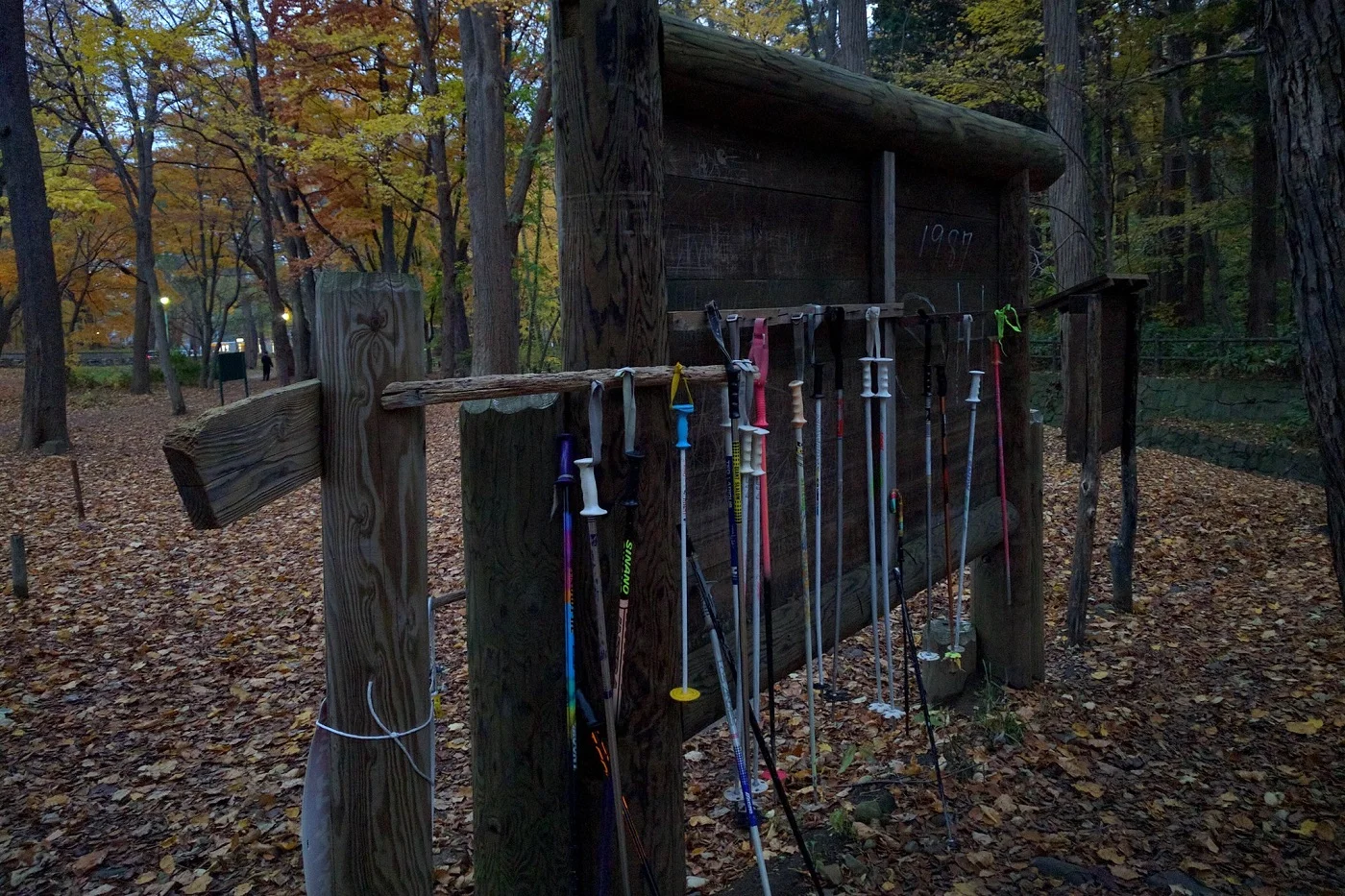
Our recommendations are based on thorough independent research, testing, analyses, and comparisons of different products. When you make purchases through links on our website, we may earn affiliate commissions.
Whether you’re taking on the Appalachian Trail or shuffling through the Big Tree Trail in Sequoia National Park, trekking poles can be an invaluable hiking accessory.
Also called hiking poles or hiking sticks, trekking poles have a striking resemblance to ski poles and are a huge upgrade over hiking staffs and walking canes. Though they may not be a must-have for every hiker or trail, trekking poles undoubtedly help ensure your hiking experience is comfortable and well-paced.
Trekking poles keep you stable on tough, uneven, and steep terrains as well as help minimize the impact on your knees and joints. Additionally, downhill climbs are a little less scary when you have extra footing on the ground.
They afford you a full-body workout as the workload is shared between your upper and lower body. Furthermore, trekking poles can be used to set up ultralight shelters, help clear paths, act as DIY duct tape dispensers, camera mounts, props for a clothesline, or even weapons in case of animal attacks.
You can even use them as probes and supports during river crossings.
That said, trekking poles might not be necessary for short treks on relatively flat terrain or ultralight hiking trips where weight and bulkiness are major concerns.
With that in mind, if you’re looking for the best trekking poles in the market, then you can’t go wrong with the picks we have reviewed below. The selection is a result of rigorous testing and on-the-ground usage over varying terrains and hiking styles.
We’ve also included a handy buying guide at the very tail end of the article to make your decision even more straightforward.
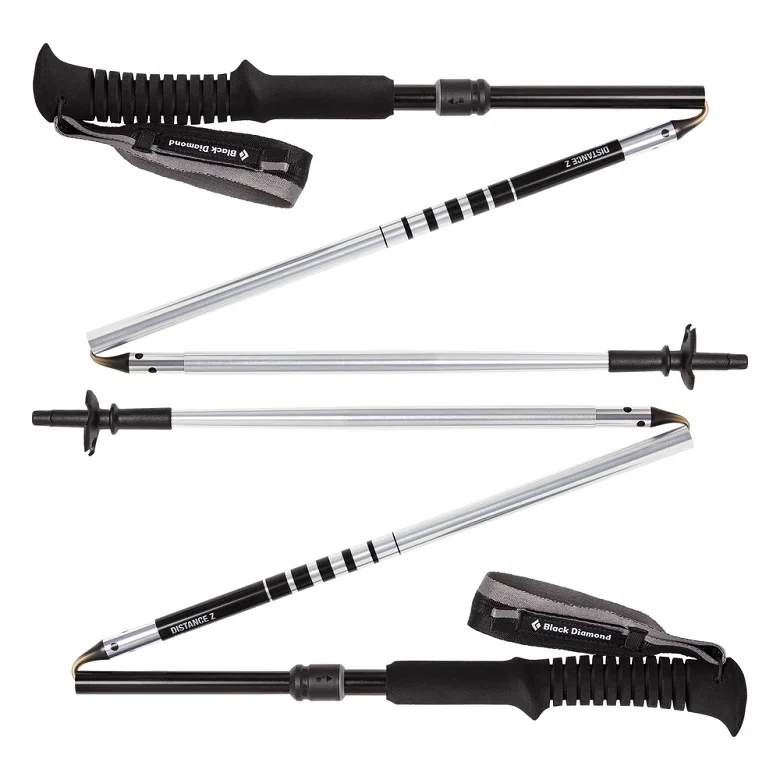
The Distance Z and Alpine Carbon Cork trekking poles are just a few of the many outdoor gears made by Black Diamond Equipment. The company has slightly over thirty years in the industry, so you can be sure these are good deals.
Available in seven fixed-length sizes, the Distance Z poles have three-section shafts that fold down into Z-shapes. While the pole shafts in the Distance Z poles are made of aluminum, those in the Alpine Carbon Cork ones are made of carbon fiber.
As far as appearances go, I love the forest green and black colors on the Alpine Carbon Cork poles over the conventional silver and black on the Distance Z poles. Anyway, how does either function on the trail?
Both trekking poles cost quite a bit more than what the competition offers. This is irrespective of the pole type or its materials.
Take the Distance Z poles, for instance, they have a basic foam grip and fixed-length aluminum shafts. Although the grip has a nice functional choke-up extension, palm or finger contouring on the grip would have been more comfortable than the included grooves.
Expectedly, the Alpine Carbon Cork poles are equally pricey thanks to their cork/foam grips and carbon fiber shafts. However, the price is still a few more dollars than what you would pay for other alternatives.
While both poles have interchangeable tips and are highly compatible with many accessories, the included baskets are irreplaceable and barely functional in snow.
Notably, a variant to the Alpine Carbon Cork poles called the WR Trekking Poles has a “Whippet Ready” grip. The grip makes it easier to prop up ultralight tents.
The 51-inch Distance Z trekking poles weigh only 14.2 ounces making them one of the most lightweight options yet. In addition, the poles fold down into a small compact bundle with a collapsed length of 17 inches.
Each swing on the trail felt light and natural and packing the poles away was a breeze. The Distance Carbon Z model is even lighter owing to the carbon fiber shaft.
At only 17 ounces, the Alpine Carbon Cork poles are very lightweight but not as much as other carbon fiber poles I tested. Furthermore, the collapsed length of the poles is about 24 inches, which might be too large for some hikers and backpackers.
The mud baskets in both pairs feature notches that come in handy in locking the poles into a compact size.
The Alpine Carbon Cork trekking poles are made of thick carbon fiber shafts with durable aluminum lever locks. I wasn’t able to break them on the trail despite stressing the poles on gravel and screes. The poles will more than suffice for lengthy thru-hiking trips in the backcountry without any issues.
Their FlickLock lever mechanism secures the pole sections in place sufficiently with a quick and easy snapping motion. A tiny Allen key is included to help adjust the tightness of the lever locks. I would have loved it if the key came in a zippered pouch as it is just too easy to lose.
On the other hand, the Distance Z poles feature aluminum pole sections interconnected by a burly Kevlar cordage. The aluminum poles don’t suffer from the shortcomings of say carbon fiber, which is bound to snap, chip, or crack under pressure.
The included internal locking mechanism allows for quick deployments and considerable weight savings. You only need to pull the first segment away from the grip until you see the push-button pop out. The Kevlar cord is cone-shaped to ensure quick pole alignment during deployment.
Keep in mind that length adjustability is out of the question with the Distance Z trekking poles. I had to pick the right length at purchase and matching them to changes in terrain was impossible.
The Alpine Carbon Cork and Distance Z trekking poles are good representatives of either type of pole. I was particularly impressed with either’s durability and ease of operation.
If you are looking for a good fixed-length pair of poles then the Distance Z ones are an unbeatable deal. For telescoping poles, you can’t go wrong with the Alpine Carbon Cork poles which feature cork/foam grips and carbon fiber pole sections.
That said, both models are way costlier than other equivalent options out there in the market. Plus, they both have
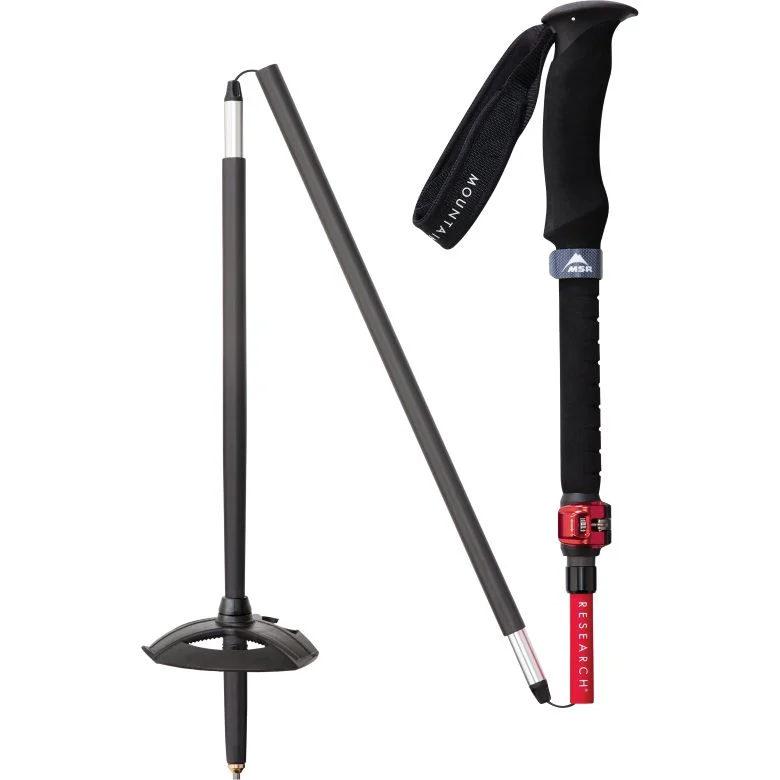
If you don’t mind the extra ounces, the MSR DynaLock Ascent Carbon Poles are a nice change of pace. The poles feature a Z-folding design with three main pole segments interconnected by a Kevlar-reinforced tension cord. Their subtle black color style is well complemented by the pink-red accents in the middle section.
Mountain Safety Research (MSR) makes this model in two sizes – small and large. The large version can be adjusted from 47 inches to 55 inches while the smaller model extends from 39 inches to 47 inches.
Swift height adjustments on the poles are made painless by the combination of an external lever and push-button locks. The lever lock is considerably low-profile and made of rugged anodized aluminum. Adjustments can be done with minimal effort and even tensioning the clamp can be done tool-free.
Deploying the poles involves unfolding them and pulling away from the section just under the grip extension until the push-button pops through the shaft. A satisfying click reassures you that the segments have been securely locked in place.
Even on demanding hikes, the DynaLock Ascent poles were able to bear my weight and that of my backpack without slipping.
The DynaLock Ascent trekking poles are made with snowshoeing and alpine climbing in mind. They come with both standard mud baskets and snow baskets, so you don’t miss a season. Though I am barely six feet tall, being able to extend the pole up to a maximum height of 55 inches helped greatly when going downhill.
The poles feature a nicely contoured EVA foam grip with a textured extension and a padded strap. The comfy grip and the pole’s feathery weight allowed for a relaxed, blister-free experience even during extended hiking trips.
The only quibble I can think of about the poles is that the top of the handle was a bit flatter than I’m used to. Keep in mind that rounded handles offer a more comfortable palming surface when going downhill.
MSR’s DynaLock series consists of the Trail Backcountry Poles, the Explore Backcountry Poles, and these MSR DynaLock Ascent Carbon Poles. The Ascent Backcountry Carbon poles are easily adjustable, comfortable, perfect for tall people, and will perform well on a wide variety of terrains. However, the extra height almost correlates to a higher price tag and larger packed size.
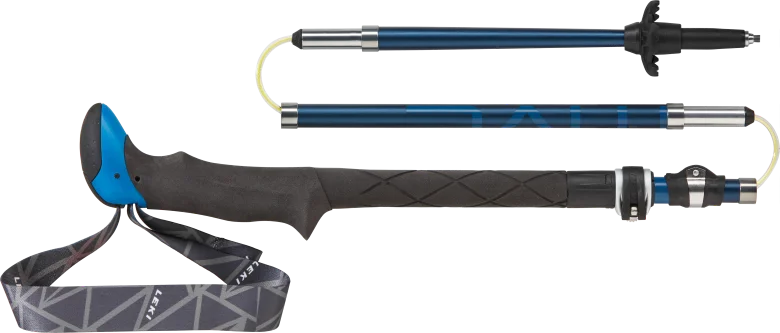
Leki’s Micro Vario Carbon and Cressida Trekking Poles are comfortable, ergonomic, and specifically engineered for women. The Leki brand is synonymous with high-end functional outdoor gear and these two pairs of poles are no exception.
The Micro Vario Carbon Poles have a deep blue and grayish color style with pink highlights on their grips. The “Vario” in their name implies that the poles are height adjustable from a minimum length of 39 inches to about 47 inches.
Similarly, the white and black Cressida telescoping poles can be extended from a minimum of 25 inches to a maximum of 49 inches. Keep in mind that their newer version has a longer minimum length starting at 35 inches.
The Cressida and Micro Vario Carbon trekking poles are perfect for women with heights under 5 feet and 8 inches.
The Cressida Trekking Poles feature the easiest to deploy locking mechanism yet. The two external lever locks are operable with minimal effort and are very effective at locking the pole sections in place. With a quick and simple flick action, I was able to adjust the pole length in seconds.
Comparatively, the Leki Micro Vario Carbon poles were a bit complicated to assemble at first. Their foldable design necessitates the two included external locking mechanisms. These include the Speed Lock 2 to make height adjustments and the External Locking Device (ELD) to secure the poles in a usable state.
Unlike its telescoping counterpart, you have to first lock the Speed Lock lever lock in the Micro Vario. Then, pull the uppermost pole section away from the grip extension until you hear a click. Initially, I had to yank the upper pole segment a bit forcefully for the rest of the sections to connect well together.
That said, I was able to get the hang of it after a few deployments.
Both pairs of trekking poles are lightweight yet sturdy. The Cressida poles are made of aluminum while the Micro Vario Carbon poles feature carbon fiber shafts interconnected with Kevlar-reinforced cords. They weigh about a pound for each pair making them ideal for backpackers and hikers.
The poles didn’t exert too much strain on my arms and each pole plant and swing felt effortless and effective. The Micro Vario poles are very portable as they can fold down into a small, compact 16-inch bundle. Moreover, the included travel bag helped me stash them away in my backpack with ease.
Comparatively, the Cressida poles have a collapsed length of about 25 inches, which was a tad inconvenient to stow away.
These Leki trekking poles are ideally sized for most women’s heights and can be adjusted for even better personalization.
The foam grips are not only soft and comfortable to hold but are egg-shaped at the top for easy palming during steeper terrains. Additionally, the grip on each pole has an 8-degree corrective angle to allow for neutral positioning of the hand.
The straps especially on the Cressida poles can be adjusted to fit your hands comfortably while maintaining some degree of moisture-wicking.
Though you will have to pay a premium for either model, these Leki trekking poles are worthy options for most mountaineering and hiking trips. They are both built to last and won’t slow you down due to weight.
Lastly, you can get either model in women’s or men’s specific versions. The Micro Vario Carbon trekking poles even have a variant with an antishock system.
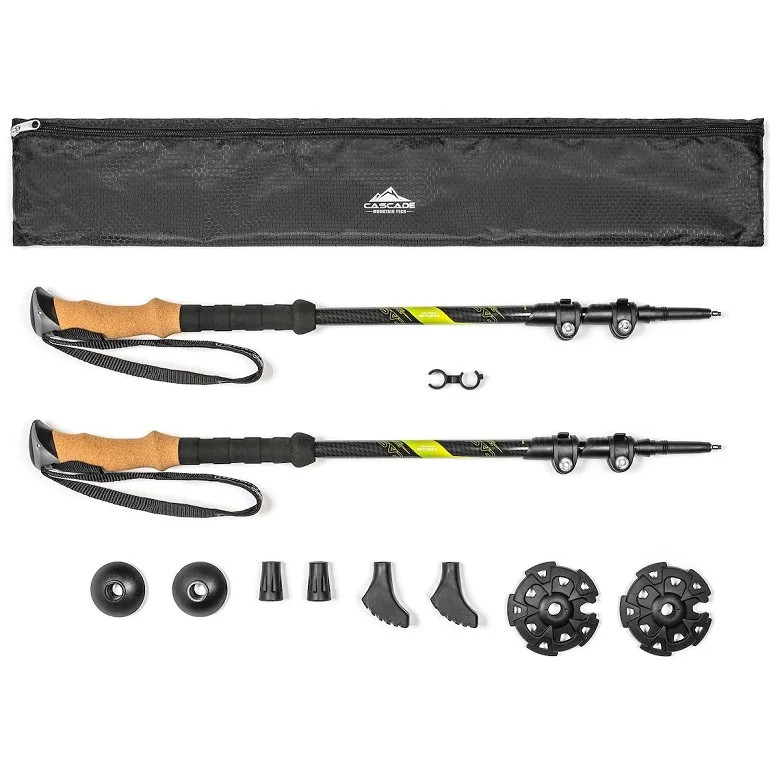
The Quick-Lock Carbon Fiber Trekking Poles from Cascade Mountain Tech are easily the best all-rounders we’ve stumbled upon in the market yet. The poles are incredibly feature-rich without being exorbitantly priced.
To begin with, it is available in over four color styles including black/green, black/blue, gray/blue, and white/red. Additionally, they come with features almost exclusive to premium models such as carbon fiber shafts and cork grips.
The CMT Carbon Fiber Quick Lock trekking poles are inexpensive without too many compromises.
Their comfortable grips include EVA foam extensions to allow for a variety of hand positions. The grip itself is contoured to ensure your hands don’t slip while traversing different terrains. Furthermore, the poles come with soft, adjustable wrist straps that offer some degree of moisture-wicking.
Surprisingly, these poles are loaded with plenty of accessories including tip covers, baskets, a travel bag, a pole clip, and so much more.
Aside from the standard carbide tungsten tips, there are included boot tips and small rubber feet for use on rock trails and asphalt. The snow and mud baskets make the poles super versatile for use throughout all the seasons.
They also come with a carry case, measuring 29 inches long and 5.25 inches wide, to help you stash away the poles and included accessories. I found the included pole clip a bit gimmicky since it barely worked as it was supposed to.
That said, at this price range, some minor imperfections are only expected.
Firstly, the poles pack down too large with a collapsed height of 26 inches and the weight of either pole at 8.3 ounces.
The poles looked unsightly poking out the sides of my backpack. In addition, storing them inside the pack was even worse as they snagged, punched holes, and ruined any fabrics in the pack. So, always ensure they are packed away inside the travel bag for the best experience.
Secondly, the lever locks are made of plastic save for the tensioning thumb screw. The plastic material is bound to develop hairline cracks over time, especially when under too much clamping tension. Furthermore, I noticed that the pole tips tend to wear out far quicker than usual.
Despite the plastic material, I found the “Quick-Lock” lever lock rather easy to use. With just a simple flick, I was able to extend and lock the poles within the 26-inch and 54-inch length allowance. The thumb screw replaces the need for a screwdriver or Allen key to adjust the tension of the lever.
The Carbon Fiber Quick Pole costs about a third of what you would pay for a high-end pair of trekking poles. Despite having a few flaws here and there, these poles provide you with everything you would need in a pair of good-quality trekking poles.
The poles will suffice for trekking hobbyists who might be skeptical about shelling out premium trekking poles.
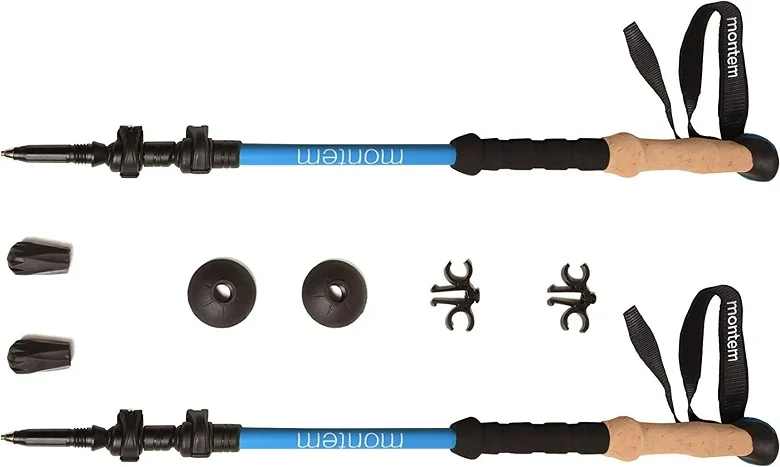
Montem Outdoor Gear seems to have cracked the code on how to make high-quality gear while keeping them very affordable to consumers. The Ultra Light 100% Carbon Fiber Trekking Poles are inexpensive and made for both men and women.
These 3-piece poles are available in matte black and matte blue color styles. Further, they come with carbon fiber pole shafts, tungsten carbide tips, and accessories such as baskets, two-pole clips, and rubber tip protectors.
Ascending rocking screes and alpine climbs was no issue with these capable carbon fiber poles. They weigh just under a pound so lifting and swinging the poles was pretty much effortless. That said, carbon fiber poles may shutter or crack under immense impacts.
So, you should keep your pole plants within the trail to get better longevity out of these poles. Alternatively, you can get the similarly designed aluminum options made by the same company.
The included flip lock lever mechanism made it a breeze to tweak the pole length on the trail. However, during my initial field tests, the poles were making a distant but annoying rattling noise. Fortunately, the lever lock just needed to be tensioned a bit to solve the problem.
Make sure to tighten the twist screw a bit before using the poles else they’ll get looser with each plant. That said, you can extend the poles from 24 inches to an impressive 53 inches, which will suffice for most tall people.
Accessories coming loose was another issue I encountered with these poles. So, you might want to double-check the accessories are mounted tightly before hitting the trail.
The EVA foam grip offers decent comfort and its extension allowed me to change my hand position without having to readjust the pole length. This was especially useful when climbing steep terrains and going downhill.
The padded wrist straps on either pole provide acceptable levels of comfort and adjustability.
However, adjusting the straps to get them just right is a bit problematic. You have to deal with removing the tension block out, fiddling with the ends of the straps to position them at the desired length, and lastly replacing the block to secure the strap in place.
Yet another good-quality pair of trekking poles within the reach of many outdoor enthusiasts. Montem’s Ultra Light 100% Carbon Fiber trekking poles are lightweight, sturdy, and comfortable without breaking the bank.
They might pack larger than most and may show negligible cosmetic wear after a few hiking trips, but their price is unbeatable.
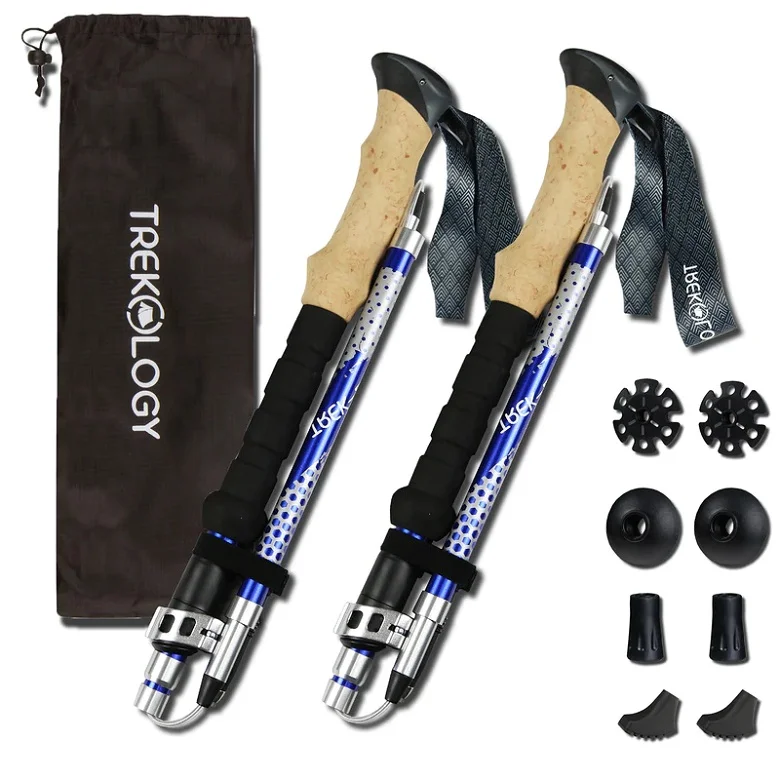
The budget category of trekking poles keeps getting better and better every day. Trekology keeps the ball rolling with its new Trek-Z 2.0, which is lighter, longer, and more durable than its predecessors.
The Trek-Z 2.0 comes in two main sizes with max lengths of 47 inches and 53 inches. Either size can be bought in blue or black color styles or you can go with their other variant that has cork grips. Yes, these poles feature aluminum shaft sections and an EVA foam grip.
Accessories such as rubber tips, mud stops, snow baskets, and rubber feet are included with the Trek-Z 2.0 trekking poles.
Priced about a third of most premium brands, the Trek-Z 2.0 still managed to bring along strong durable materials and outstanding practicality. The 7075 aluminum pole shaft stands tough against slick rock surfaces and rough terrains.
The poles even have metal lever locks, which is often a rarity in some costlier trekking poles.
The textured foam grip and extension felt comfortable and had some perceivable moisture-wicking qualities. Additionally, being able to adjust the length and fit of wrist straps resulted in more confident and comfortable swings over a variety of terrains.
The rugged components bring the weight of the poles to about 1.3 pounds, which might be inconvenient to ultralight hikers. The folding design is perhaps the poles’ saving grace as they can fold down into a manageable 15-inch long bundle.
The Trek-Z 2.0 poles also feature Velcro straps to help compact them even more. Moreover, a travel bag for storage and hauling is included.
Setting up the poles was very quick and easy thanks to the all-familiar flip-lock mechanism. The included thumb screw came in handy for adjusting the tension of the external lever lock.
Lastly, as with all cheaply produced items, brace yourself for some minor inconveniences. The threads near the base of the poles barely secure any of the included baskets or caps. Just a few miles of rocky or snowy trails are enough to loosen the baskets completely off.
Additionally, whenever I got them stuck in the mud, yanking them out would always result in the top coming completely apart.
The Trek-Z 2.0 remains a favorite among all types of hikers and backpackers. The poles may be heavier than most comparable options but they sure do pack down small. Generally, these poles are ideal for anyone looking for okay-quality budget options. They should also suffice if you don’t intend to hike with them for lengthy periods.
| Hiking Pole Name | Type | Locking Mechanism | Shaft Material | Grip Material | Weight | Max Length | Collapsed Length |
|---|---|---|---|---|---|---|---|
| Black Diamond Equipment Distance Z Trekking Poles | Foldable/Fixed-Length | Push-button | 7075 Aluminum | EVA Foam | 0.89 lbs. | 51.00 in. | 17.00 in. |
| Black Diamond Equipment Alpine Carbon Cork Trekking Poles | Telescoping | External Lever | Carbon Fiber | Cork w/ EVA Foam Extension | 1.07 lbs. | 51.00 in. | 24.00 in. |
| MSR DynaLock Ascent Carbon Poles | Foldable/Adjustable | External Lever | Carbon Fiber | EVA Foam | 1.13 lbs. | 55.00 in. | 17.50 in. |
| Leki Women's Micro Vario Carbon Poles | Foldable/Adjustable | External Lever | Carbon Fiber | Foam | 1.01 lbs. | 47.24 in. | 15.75 in. |
| Leki Women's Cressida Trekking Poles | Telescoping | External Lever | Aluminum | Foam | 0.97 lbs. | 49.21 in. | 25.20 in. |
| Cascade Mountain Tech Carbon Fiber Quick Lock Trekking Poles | Telescoping | External Lever | Carbon Fiber | Cork w/ EVA Foam Extension | 1.04 lbs. | 54.00 in. | 26.00 in. |
| Montem Ultra-Light 100% Carbon Fiber Trekking Poles | Telescoping | External Lever | Carbon Fiber | EVA Foam | 0.95 lbs. | 53.00 in. | 24.00 in. |
| Trekology Trek-Z 2.0 Trekking Poles | Foldable/ Adjustable | External Lever | 7075 Aluminum | EVA Foam | 1.35 lbs. | 53.15 in. | 15.00 in. |
Beyond personal preferences, some of the key factors to consider when shopping for a pair of trekking poles include their weight, portability, durability, type, ease of adjustability, and so much more. Other features such as the handle and locking mechanism might seem insignificant but are similarly important to consider.
Getting a pair with a mix of all these factors will be sure to grant you most of the benefits of using trekking poles. Before we jump onto these factors, it’s prudent that we get acquainted with the main parts of a trekking pole.
Starting from the top, we have the grip, wrist strap, pole shaft segments, and their locking mechanisms, baskets, and, finally, tips at the base of the pole. Some poles might include features such as shock absorbers in the shaft as well as compasses and flashlights embedded in the grips of the poles.
There are two main types of trekking poles – fixed-length and adjustable poles. Fixed-length poles come in non-collapsing and folding kinds while adjustable poles can further be categorized into folding and telescoping types.
Since non-collapsing fixed poles are just glorified hiking staffs, they are understandably uncommon in the market. These poles can be good options for fast hikers and ultralight mountain trekking as they bring along considerable weight savings and improved strength.
The major downside of non-collapsing fixed poles is that packing them away when not in use can be very challenging. Fortunately, fixed-length poles come in folding designs which takes care of the portability issue.
That said, both styles can’t be adjusted to counter varying terrain conditions including uphill and downhill climbs. So, you might want to stick with height-adjustable trekking poles for added versatility and adjustability.
The pole length is an important aspect to consider, especially when buying fixed-length trekking poles. A good approach to try is to go for poles that are about 63-65% of your full height. You should also follow the 90-degree rule to better single out the right pair of poles for you.
The rule dictates that when holding your poles, they should be at the same height as that from your feet to your hands with your upper arm being perpendicular to your forearm. Give or take a few inches off that measurement and the poles should be suitable for all terrains.
Telescoping poles are the most common types amongst backpackers and other campers. They are durable and allow for pole shaft height adjustments, which is very useful for maintaining stability over varying terrains.
These types of poles comprise two or three sections that slide in and out of each other and are secured in place using an internal or external locking mechanism.
Three-section telescoping poles are arguably the most long-lasting and strongest variants while still allowing a wide range of height adjustments. Two-section poles are even stronger due to fewer moving parts but offer little in terms of pole length adjustments.
The biggest letdown to telescoping poles is that they are often heavier, bulkier, and don’t pack down as small or compact as folding poles. Keep in mind that the shaft segments must have increasingly wider diameters for the telescoping design to work.
Folding poles employ similar mechanics to those found in white canes or tent poles. Each pole has at least three sections connected by an internal tension cord. During set-ups, the segments are unfolded to form a single shaft that is then secured by a locking mechanism.
The folding style and internal tension cord mean that the segments can be of equal diameters, which results in a more lightweight load. Folding trekking poles are by far the most portable. They can fold down to about a third of their overall profile.
Telescoping poles tend to slide back into each other when the clamps fail or loosen, unlike foldable poles which can’t easily come undone.
Moreover, folding poles can come in either fixed or adjustable designs. The latter utilizes a telescoping mechanism in at least one section so you can tweak the shaft length as needed.
When going down steep grades or crossing fast-flowing streams, your trekking poles should be able to bear your weight and not bend or snap under pressure. The pole shaft material should be durable and strong enough while still ensuring considerable weight savings.
Pole shafts are mostly made of either carbon fiber, aluminum alloy, or composite material.
Carbon fiber is often the preferred option owing to its stiffness, strength, and feathery weight. However, carbon fiber is generally more expensive than aluminum and naturally very brittle. Carbon fiber will snap or splinter under immense stress and even chip or crack on rocky pathways.
On the other hand, compared to alternative carbon fiber materials, aluminum is more affordable and robust. Under stress, aluminum alloy poles may flex or bend, but unlike carbon fiber ones, they won't break or snap easily. Aluminum is also admired for having a high strength-to-weight ratio.
In a nutshell, carbon fiber poles are ideal for when weight is a concern while aluminum poles perform best for long treks.
Save for non-collapsing fixed poles, all the other trekking poles have locking mechanisms to secure the pole sections in place. For adjustable trekking poles, the locking mechanism equally helps maintain the pole at the desired length.
Twist locks and lever locks are the two main locking mechanisms used in trekking poles. Lever locks are mounted externally while twist locks are installed inside the pole sections.
Lever locks work by using a small lever to pull together the two plates wrapped around the pole. They are a favorite among hikers and backpackers due to their ease of operation and low maintenance. Additionally, since they are mounted on the outside of the poles, you get visual confirmation on whether they are locked or not.
Push-button locks are a slight variation of external lever locks.
They are installed inside the pole segments with a button popping out of a hole on the pole. Pressing the button releases the lock and the pole segments become collapsible. Push-button locks are used together with external lever locks for optimal performance.
On the other hand, twist locks comprise an expander that can be manipulated by a twisting action to expand or shrink as needed. To lock the poles, the expander puts pressure inside the walls of the pole segment and locks it in place to keep it from sliding.
Twist locks heavily rely on friction to work accordingly, so you can expect some premature wear on poles with these locks. Though they are more affordable and provide precise adjustments, this locking mechanism is harder to operate and not as strong as external locking mechanisms.
Moreover, twist locks tend to loosen up over time when in use and they have a higher potential of getting stuck if overtightened. It’s no wonder they have been slowly phased out by lever locks.
The grip is often an overlooked feature when shopping for a good pair of trekking poles. Yet, it makes a huge impact on the overall performance and effectiveness of the poles. A good quality grip could mean an end to blisters or even lengthier treks due to the improved comfort, energy efficiency, and experience.
Though you can always replace the pole grip, it is always a good idea to buy a suitable option right off the bat. Here, you want to focus on the material of the grip as well as its shape and ergonomics.
Pole grips are made of a variety of materials including plastic, rubber, foam, and cork. Steer clear of poles with plastic grips as the material will cause a lot of friction against your hands resulting in blisters and sore spots.
Cork grips offer the best performance in terms of comfort and durability. They are naturally shock-absorbent, lightweight, and moisture-wicking. Additionally, cork tends to slowly conform to your hand over extended use resulting in a comfortable grip every time.
Trekking in the hot summer necessitates the use of poles with cork grips for their excellent sweat absorption.
Grips made of foam feel very soft to the touch and offer decent moisture absorption. Moreover, foam grips do a great job at minimizing vibration on your hands but not as effectively as cork grips. They deteriorate much faster than cork grips.
Ethylene-vinyl acetate (EVA) foam is usually the go-to option for most manufacturers as it produces rubber-like grips that are soft and flexible.
Rubber grips are affordable, insulative, shock-absorbent, and perfect for cold-weather hiking trips. However, the rubber material tends to blister or chafe hands in summer weather.
Lastly, some grips are made of a combination of materials to help you get the best of either option. Foam/cork is often the best combo as they afford you a comfortable grip with all the moisture-wicking and shock-absorbing qualities.
Beyond the grip material, it is worth nitpicking on the grip shape to get the best performance possible.
Ergonomic grips will most likely have a slight tilt to ideally match the natural resting position of the hand. Additionally, these pole grips possess contours of the hand for an even more comfy handling experience.
Comparatively, standard pole grips are usually smooth which might result in hand slippage or blisters over time.
The grip diameter should equally be considered to ensure comfort while taking on trails. If you have larger than average hands then it makes sense to go for poles with large-diameter grips.
In most premium models, manufacturers include a choke-up extension – a second smaller grip just below the main one. The main advantages of grip extensions include smoother descents and ascents, improved balance and leverage, and more pressing power.
Furthermore, the grip extension beats having to regularly adjust the length of the trekking pole with each change of terrain.
That said, they shouldn’t be the reason to pay more for a pair of trekking poles since you can always make your own with just tape.
Functionally, wrist straps help add power and stability to trekking poles without you having to death-grip them. They also free up your hands to do other tasks while the poles dangle from your wrists.
If you’re undecided about whether to use straps or not then you might want to go for poles with quick-release straps. The wrist straps should ideally be comfortable and ergonomically shaped to prevent potential chafing or blistering.
You want to choose poles with some foam cushioning and a fleece or soft chamois material instead of the typical nylon webbing straps.
Test your new poles to make sure the wrist straps are at their most breathable and comfortable. Keep in mind that chafing could be caused by something as simple as a seam rubbing on the back of your hand. Additionally, the wrist straps' features will be most enjoyable for you if you know how to use them correctly.
Finally, some trekking poles have full-hand coverage wrist straps and others even have right- and left-hand specific wrist straps.
Trekking poles often come with carbide metal tips to help add traction on a variety of ground surfaces including ice, rocks, and dirt. Carbide tips are incredibly durable but often make a lot of vibrations and noise.
Rubber caps or rubber feet are added to the tips to provide better traction and reduce vibration. The feet help provide better forward propulsion and stability over asphalt and other hard surfaces. Mud, snow, and powder go just above the tips to prevent you from sinking too deep in muddy soil or slushy grounds.
Wider baskets will be even more effective at dealing with a few inches of snow but they might snag at roots or bushes.
Although you can buy these accessories aftermarket, ideally you want to get poles with them included right out of the box.
Shock absorption – a gimmick at the surface but a somewhat good-to-have feature for going downhill. It mostly comprises internal spring mechanisms installed near the pole tips. The shock absorbers help reduce impact from the repeated striking of the ground.
Poles with shock absorbers fetch a premium and weigh slightly more than your standard trekking poles.
From our experience, we feel the benefits of such types of poles can only be best appreciated by people with existing joint pains or complications. That said, you can still find some in-between models that allow you to turn off the shock absorption.
How much a pair of trekking poles weigh depends on the materials they are made of and included features. Since you don’t want it to be a workout trying to lift and swing the poles during your hike, a lightweight set of trekking poles is always preferred.
Pole shafts made of carbon fiber are the most lightweight as compared to aluminum and composite variants. Extra features such as shocks, baskets, and beefy locking mechanisms often mean a heavier load to bear.
Weight may not be a concern for beginners or short day-hikes. However, if you are embarking on a multi-day thru-hike or an alpine climbing trip then a lightweight set of trekking poles will help you go further.
Next, you might want to consider the packability of your ideal trekking poles. Packability is especially crucial for people who prefer carrying the trekking poles inside of their backpacks whenever applicable. Look for the indicated collapsed size of the given set of poles to better gauge if they will fit in your packs accordingly.
Lightweight poles with shorter collapsed lengths are always preferred when portability is on the line.
As we mentioned earlier, aluminum is king when we talk about durability. The material is less prone to snapping or shattering as compared to carbon fiber. Aside from the material, other factors that might affect the longevity of the poles include the diameter of the pole and the thickness of the material.
Thicker and wider pole shafts will always outlast their thinner and narrower alternatives. Since wear and tear are inevitable in any product, an accompanying customer-friendly warranty should be a top priority when shopping for a pair of trekking poles.
Some trekking poles are tailored specifically for women, men, and kids, while others are said to be unisex. However, the major distinctions between either seem to be in terms of the pole length, weight, grip size and style, and color.
Women-specific trekking poles will most likely feature shorter maximum lengths, thinner grips, and stereotypically-feminine color styles. Ultimately, you should gender as the tie-breaker after considering all the factors we’ve discussed above.
Trek On!
Sissy sticks, hiking sticks, mountaineering poles — call them what you want, but trekking poles are a game-changer for anyone who loves the great outdoors. Trekking poles save knees and joints, help provide an upper and lower body workout and make ascents and descents less stressful.
Beyond thru-hiking and backpacking, trekking poles are a staple for Nordic Walking.
Nevertheless, you must learn to use trekking poles the right way to be able to reap all their benefits. How to hold them properly, how to size them correctly with varying terrains, and of course how to walk with them.
Finally, remember to Leave No Trace by sticking to designated trails and avoid scuffing up rocks and vegetation by using rubber caps over the pole tips. Keep in mind that some areas prohibit the use of trekking poles as they might damage their fragile ecosystems.
Charlie Leone
Website Owner/Editor
Welcome to CampingManiacs